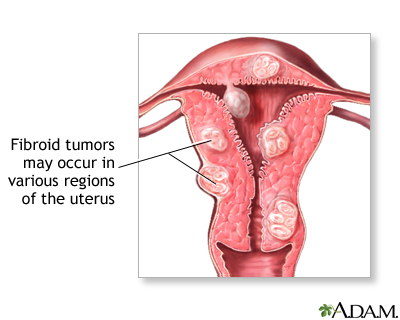Uterine Fibroids
Uterine fibroids are benign growths that develop from the muscle tissue of the uterus, and are also called leiomyomas or myomas. They are the most common non-cancerous tumors in women of childbearing age.
What Are Uterine Fibroids?
Fibroids are muscular tumors that grow in the wall of the uterus (womb), and are also known as leiomyomas. Fibroids are almost always benign (not cancerous). Not all women with fibroids have symptoms. Fibroids can grow as a single tumor or there can be many of them in the uterus. Women who do have symptoms often find fibroids hard to live with and can affect their daily lives. Some women have pain and heavy menstrual bleeding.
Uterine fibroids are the most common non-cancerous tumors in women of childbearing age. About 20 percent to 80 percent of women develop fibroids by the time they reach age 50. Fibroids are most common in women in their 30s and 40s, but they can occur at any age.

What Are The Symptoms of Uterine Fibroids?
Many women with fibroids have no symptoms. If you do have symptoms, they may include:
- Heavy or painful periods or bleeding between periods
- Anemia (when you don’t have enough red blood cells)
- Feeling “full” in the lower abdomen, sometimes called pelvic pressure
- Bladder pressure
- Pain during sex
- Lower back pain
- Reproductive problems, such early labor
- Rectal pressure
How Are Fibroids Diagnosed?
Your doctor may find that you have fibroids when you see her or him for a regular pelvic exam. There are other tests that your provider can order to see the size, location, and number of fibroids in your uterus. These tests and procedures might include:
- Ultrasound – Uses sound waves to produce a picture of the uterus and other pelvic organs
- Hysteroscopy – A hysteroscopy is a procedure that allows your gynecology provider to look inside of your cervix and uterus using a long, thin camera
- Hysterosalpingography – An HSG is a special x-ray test that can find changes in the contour and shape of the uterus
- Sonohysterogram – A sonohysterogram involves injecting saline into the uterus while simultaneously taking ultrasound pictures
- Laparoscopy – A laparoscopy is a surgical procedure in which a thin, lighted camera called a laparoscope is inserted into the abdomen through a small incision
Your gynecologist may also order imaging tests such as an MRI or CT scans.
Do Uterine Fibroids Require Treatment?
Most women with fibroids do not have symptoms. For those who do, there are treatments available. For women nearing menopause or for fibroids that are small or not causing symptoms, treatment may not be required. The treatment options depend on your own wishes, the severity of your symptoms, and the size and location of the fibroids.
How Are Uterine Fibroids Treated?
Some common treatments for uterine fibroids include medication, minimally invasive procedures, and surgery. Your doctor can help you determine the best treatment option for you based on your specific situation. It is important to talk to your doctor about all of your options and the potential risks and benefits of each.
Your gynecologist will consider many factors before recommending a treatment for your fibroids, including: your age, general health, severity of your symptoms, where your fibroids are located, the type and size of your fibroids, and whether you are pregnant now or want to get pregnant in the future.
If you have uterine fibroids but have no symptoms or problems, you may not need treatment. If you are close to menopause, your health care provider may find that your fibroids are shrinking, which is common during and after menopause.
Related Articles
Period Problems, Is My Period Normal?
Nearly all women will experience menstrual problems at one time or another. Changes in your period are normal over your menstruating years, but it can be hard to know what is normal, and what signifies a problem.


